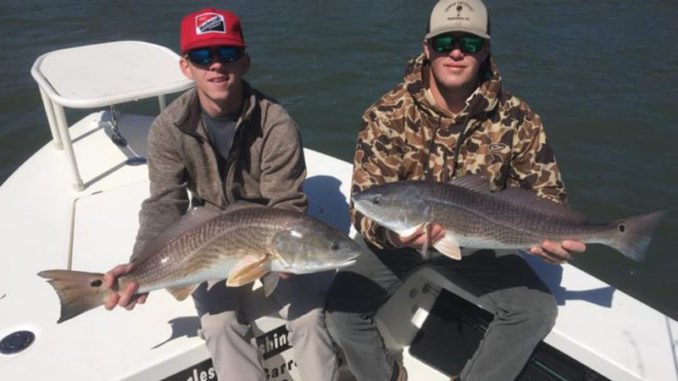
Swings in water temps not stopping anglers from catching redfish
One of the biggest challenges facing redfish anglers lately is the swing in water temperatures from one day to the next thanks to unseasonably warm days mixed in with some relatively cold nights. This has caused as much as a 6 degree swing in the water temperatures.
While this can cause the redfish to modify their behavior, it can mean some exciting fishing for anglers who know how to handle this situation. Capt. Garrett Lacy of Charleston Fishing Adventures (843-478-8216) hasn’t minded the temperature swings. It’s allowed him to catch redfish in two different ways, usually during the same fishing trip.
“When the water temperatures drop that much, redfish will gang up in small schools in the main waterways. It’s common for them to be in big schools when it’s really cold. But with the warm days, they are in smaller schools that break up in the heat of the day. That’s when you can catch them in the deeper holes in feeder creeks,” said Lacy.
Live bait and patience are keys to this type of fishing
Live or cut bait is tough to beat for fishing in either locations, and fishing on the bottom or with popping corks will both work. Anglers that are casting to schooling fish should cast in front or to the outside edge of the schools. Casting into the middle of a school will scatter the fish and make them skittish.
Lacy suggests anglers use medium to medium-heavy rods, with 2/0 to 3/0 circle hooks. And when fishing on the bottom, he prefers the lightest weight needed to keep his bait in place. This varies with the current and tide, but he said 1/2-ounce to 1-ounce usually does the trick.
Anglers can increase their chances by anchoring down and casting out four rods, then placing them in rod holders. Once a redfish bites, Lacy said it’s best to let the circle hook do its job before picking up the rod. He also said having the drag set properly is important.
“There’s no need to crank the drag down too tight. If it’s too tight, that will usually result in something breaking, usually the line. But if it’s too loose, the hook might not set properly. When it’s set correctly, the circle hook will find the corner of the fish’s mouth as it swims off with the bait,” he said.
Lacy uses rods in the 6 1/2-foot to 7 1/2-foot range with Shimano Stradic 2500 and 3500 reels.


Be the first to comment